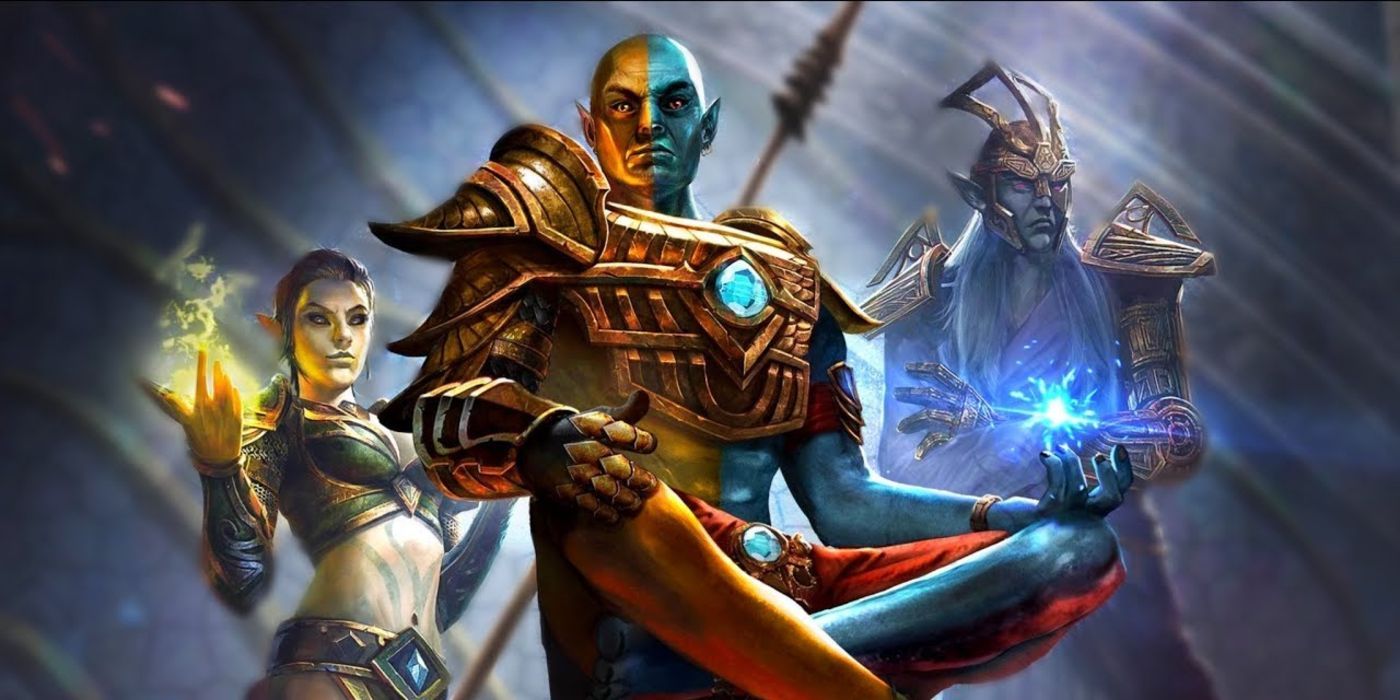
Although they are the franchise's namesake, the Elder Scrolls themselves have had a surprisingly small role to play in The Elder Scrolls. When they do appear in a games' story, their roles are varied, and their exact nature evades easy definition.
The Elder Scrolls are ancient prophecies of unknown origin which, when read by the trained eye, show the reader just one possible version of events from the past or future. There are specific roles the scrolls have played in The Elder Scrolls so far, and many of these roles have shown them containing strange powers.
RELATED: How Playing an Argonian in The Elder Scrolls 6 Will Likely Differ From Skyrim
Arena To Morrowind

No Elder Scrolls actually appear in The Elder Scrolls: Arena, Daggerfall, or Morrowind. However, the first three main Elder Scrolls games do lay some of the groundwork for the language later used to describe the Elder Scrolls.
Daggerfall, for example, ends with The Warp in the West, though the event itself was not actually described until later games. At the end of Daggerfall, the hero can choose to give the Totem of Tiber Septim to any of the major factions in the Iliac Bay, ensuring that faction's victory over the others by allowing them to activate the giant golem known as the Numidium.
In the canon, the activation of the Numidium caused a Dragon Break, in which time fractured and each possible event that followed took place simultaneously before the timeline reconverged. In practice this was to allow Bethesda to avoid establishing one choice as canon, but the core concept behind the Warp in the West also lay down the foundation of later descriptions of the Elder Scrolls.
In Skyrim’s College of Winterhold, Urag gro-Shub describes how the scrolls are a “reflection of all possible futures and all possible pasts […] all of it is true. Even the falsehoods. Especially the falsehoods.” Like Dragon Breaks, the Elder Scrolls lean on the fourth wall to some degree.
The series' flirtation with metafiction went even further in Morrowind. Vivec is one third of Morrowind’s Tribunal, and has achieved CHIM. CHIM is gained by characters in the Elder Scrolls universe when they realize they are simply figments in the dreams of an unconscious godhead, but assert their individuality regardless. In practice, the godlike powers of CHIM allow Bethesda to canonically retcon the lore, like when Tiber Septim used the power of CHIM to turn Cyrodiil from a tropical jungle into a temperate forest.
In the beginning, the Elder Scrolls were not much more than a fantasy-sounding name for the first three games. However, the origins of what they would become can be traced through the development of some of The Elder Scrolls’ weirdest metaphysical lore.
RELATED: The Elder Scrolls 6 Needs to Take One Cue From D&D
Oblivion

Oblivion was the first game to introduce an Elder Scroll as an actual object. Before the fourth game, the implication was more that the stories players were witnessing play out across the series were the sort of epic fantasy tales found on ancient scrolls, hence the name.
In Oblivion’s Thieves Guild questline, the player has to steal an Elder Scroll from the Elder Council Chambers. It was Oblivion that established the scrolls as containing ancient prophecies, and introduced the Order of the Ancestor Moths: a cult dedicated to reading the scrolls even though doing so eventually costs the cult's members their sight.
In Oblivion, the Elder Scroll that the Hero of Kvatch steals is used by the Gray Fox to rewrite history, retroactively breaking the curse of the Cowl of Nocturnal and allowing the Gray Fox to return to his old life, revealed to be Count Corvus Umbranox. The power of the Elder Scroll that appears in Oblivion resembles the series’ other metaphysical lore in a lot of ways. Like CHIM, the scroll seems to be able to be used to retroactively change events, though exactly how and the implications of such an act aren't explored in much depth. In Skyrim, the Elder Scrolls finally became central to the main story, though they are no less confusing.
Skyrim

Skyrim introduced not one, but three different Elder Scrolls across its main quest and the Dawnguard DLC. In Skyrim’s main quest, the Dragon Elder Scroll is used by the Dragonborn to look back into the past to see the moment that same scroll was used to send Alduin into the future. By using the scroll, the player is able to learn the shout Dragonrend, which forces dragons to land and becomes key to defeating the World Eater.
While the Dragonborn only gains knowledge from the Dragon Elder Scroll, it’s clear from the scroll’s part in banishing Alduin that, like in Oblivion, Skyrim’s Dragon Elder Scroll can be used to manipulate time. Backed up by Urag gro-Shub’s comments in Skyrim, it seems that the scrolls can not only show readers possible realities, but can also allow them to make some of those realities come into being.
The other two Elder Scrolls in Skyrim – the Blood Elder Scroll and the Sun Elder Scroll – appear in the Dawnguard DLC. Both Elder Scrolls belonged to Serana’s mother Valerica, and she fled with them to stop Serana’s father Lord Harkon from using the scrolls to realize the Tyranny of the Sun Prophecy.
The Tyranny of the Sun prophecy is contained across Skyrim’s three Elder Scrolls. The prophecy was created by Arch-Curate Vyrthur, a Snow Elf who wanted to curse his god Auri-El as revenge after he contracted vampirism. The prophecy was later revealed to a Moth Priest who began transcribing it from the scrolls.
Presumably the scrolls actually predate Vyrthur creating the prophecy, since the Elder Scrolls appear to predate Nirn as well as the Aedra and Daedra. The Tyranny of the Sun prophecy acts more like a curse the scrolls themselves prophesized, but it's hard to pin down exactly how this is supposed to work.
It’s not clear how Vyrthur created a prophecy that retroactively appeared on the scrolls. If there’s one thing that’s consistent about the use of the Elder Scrolls across Oblivion and Skyrim, it’s that their near-incomprehensible nature is often used to Bethesda’s advantage, allowing the scrolls to fill almost any role the studio needs for the story. What role they will play in future The Elder Scrolls gamesremains to be seen.
MORE: How The Elder Scrolls 6 Should Change the Companion System


